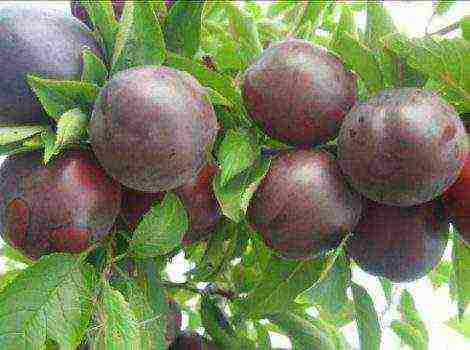Content
Melon varieties: description, photo, reviews
All varieties and hybrids of melons described here are included in the State Register and approved for cultivation on the territory of the Russian Federation.
Melon Torpedo, description and characteristics of the variety
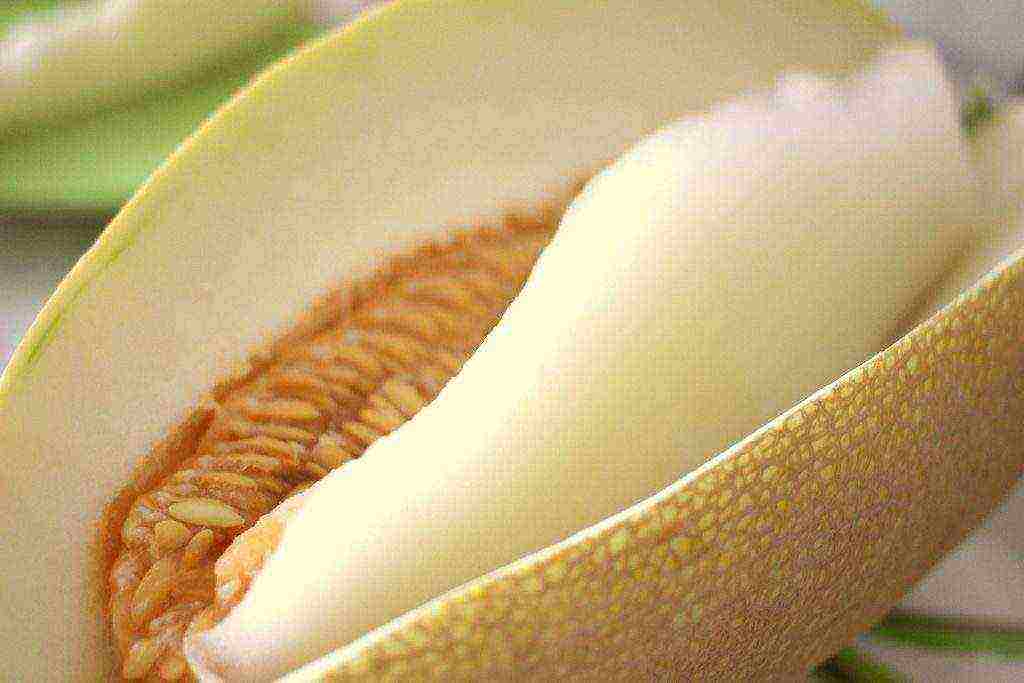
Mid-season variety. The plant is climbing. The leaf blade is medium-sized, green, dissected.
The fruit is elongated, gray, with a grayish tinge, smooth, mesh of medium thickness and medium density, mesh structure. The average weight of a torpedo melon is 2.5-6.0 kg. The pulp is greenish-white, of medium thickness, melting, tender, juicy, of excellent taste. The seed nest is medium in size. The seeds are long, of medium width, dark creamy yellow.
Yield: 1.8 kg / sq.m. The fruits retain their commercial qualities for 15-20 days after picking.
Melon variety Torpedo in 2017 is included in the State Register of the Russian Federation for cultivation in private household plots.
Originator of the variety: Agrofirm SEARCH.
Melon Kolkhoz Woman, variety description, photo

Mid-season, the period from full sprouting to the first harvest of fruits is 77-95 days. The plant is medium in size, long-leaved, the stem is thin, not coarse. The leaf is reniform, weakly globular, of medium size.
The fruit is spherical and medium-sized, weighing 0.7-1.3 kg. The surface of the fruit is smooth, yellow-orange in color, without a pattern. The mesh is sometimes found partial, coarse-meshed. The bark is of medium thickness, flexible, firm. The pulp is white, thin, fibrous, dense, semi-crispy, juicy, sweet. The seed nest is medium in size, the placenta is dry, walled, dense. The palatability of the fruit is good and excellent.
Marketable yield: 14.6-22.7 t / ha.
The variety is relatively resistant to bacteriosis; it is heavily affected by powdery mildew and anthracnose.
Variety value: good transportability of fruits.
Approved for use in the Central Black Earth, North Caucasus, Middle Volga, Lower Volga, Ural, West Siberian, East Siberian and Far Eastern regions in 1943.
Melon Ethiopka, variety description, photo

The variety is mid-season, the period from full sprouting to the first harvest is 80-91 days, 10-11 days later than the Zolotistaya standard. The plant is climbing. The leaf is medium-sized, green, slightly dissected.
The fruit is broadly round, dark yellow with an orange tinge, with a net of medium density and medium thickness, slightly segmented, smooth. Fruit weight 2.3-2.8 kg. The pulp is orange, melting, tender, juicy, of excellent taste, with a strong aroma. The seed nest is medium in size, the placenta is wall-mounted, dry, closed. Seeds are medium in size, creamy yellow.
Yield marketable fruits 89-145 c / ha, 43-49 c / ha higher than the standard. The fruits retain their commercial qualities for 14 days after picking. Flameproof.
In 2013, the Ethiopka melon variety was included in the State Register for the Lower Volga region for growing on dry land in private household plots.
Originator of the variety: agrofirm Search.
Melon Delano, description and characteristics, photo
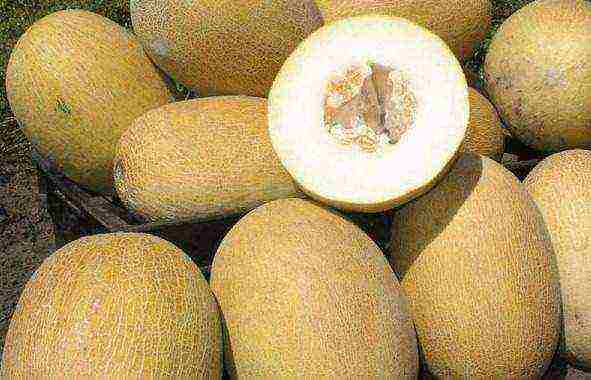
Mid-early, the period from full sprouting to the first harvest of fruits is 63-77 days. The plant is strongly plaited. The leaf is medium-sized, green, slightly dissected.
The fruit is oval, dark yellow, smooth, with a solid mesh of medium thickness. The average weight of the fetus is 1.5-2.3 kg. The pulp is light creamy, thick, tender, melting, juicy, of excellent taste, with a strong melon aroma. The dry matter content is 8.9-10.6%, the total sugar content is 5.7-8.8%. The seed nest is medium in size. Seeds are medium in size, narrow oval, pointed, light yellow. These melons are stable and transportable.
Yield marketable fruits on dry land 88-302 c / ha, 14-104 c / ha higher than Otrada and Tamanskaya standards.
The hybrid tolerates temperature extremes and is resistant to fusarium.
The Delano melon variety was included in the State Register for the North Caucasus region in 2009.
Originator: NUNHEMS (Holland)
Melon Amal, description, photo

Mid-season melon hybrid. The plant is climbing. The leaf is medium-sized, green, strongly dissected.
The fruit is elliptical, ocher in color, with a pattern in the form of dots, smooth, with a fine continuous mesh of a linear structure. The average weight of the fetus is 1.4-2.6 kg. The pulp is dark creamy, thin, melting, tender, juicy, excellent taste, with a strong aroma. The dry matter content is 8.4-11.0%, the total sugar content is 5.5-7.6%. The seed nest is small, the placenta is central, dry, closed. Seeds are medium in size, narrow oval, blunt-pointed, creamy yellow.
Yield marketable fruits on dry land are 93-140 c / ha, for Otrada and Tamanskaya standards - 108 and 88 c / ha.
Dignity: excellent transportability, resistance to fusarium.
Melon hybrid Amal F1 in 2009 was included in the State Register for the North Caucasus region.
Originator: CLAUSE (France).
Melon Lada
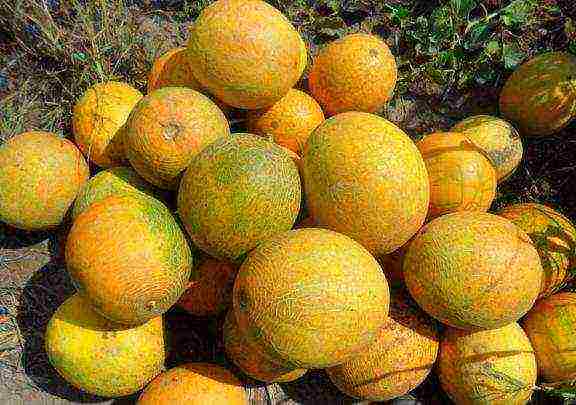
A mid-season melon variety, the period from full germination to removable ripeness (first harvest of fruits) is 74-96 days. The plant is climbing, the main lash is of medium length. The leaf is medium-sized, green, slightly dissected.
The fruit is round, yellow at the stage of maturity, without a pattern, smooth, with a solid mesh, weighing 1.5-2.0 kg, resistant to cracking. The pulp is of medium thickness, light creamy, crispy, tender, juicy, weak aroma. The taste is good and excellent. The dry matter content is 10.5%, the total sugar content is 8.4%. The seed nest is medium in size, cream. Seeds are oval, ivory. The mass of 1000 seeds is 39.6 g. The seed yield is 1.5%.
Marketable yield fruits under irrigation 211-218 c / ha, at the level of the Yuzhanka standard.
Advantages of the variety: resistance to powdery mildew, tolerance to downy mildew and aphids.
Melon variety Lada in 2005 was included in the State Register for the Lower Volga region.
Originator of the variety: All-Russian Scientific Research Institute of Irrigated Vegetable and Melon Growing.
Melon Fairy Tale
An early ripening variety, the period from full germination to removable ripeness (first harvest of fruits) 60-62 days. Maturation is amicable. The plant is climbing. The leaf is medium-sized, green, slightly dissected.
The fruit is elliptical, yellow at the stage of maturity, without a pattern, slightly segmented, with a sparse mesh, weighing 1.6-1.8 kg (up to 2.3 kg). The pulp is light creamy, 2.5-3.0 cm thick, crispy, medium juiciness, sweet, with a weak aroma, good taste. Dry matter content 11.0-12.0%, total sugar 9.0-10.0%. The seed nest is medium in size, consisting of three dry, closed placentas. Seeds are narrow oval, ivory. The mass of 1000 seeds is 41 g. The seed yield is 1.0%.
Melon yield Fairy tale: 2.1-2.3 kg / m2, for the first two collections - 0.3-0.4 kg / m2.
This melon is recommended for local consumption as it is not suitable for long distance transportation. The fruits retain their commercial qualities for 5-10 days after picking.
Dignity: resistance to powdery mildew, tolerance to downy mildew, early maturity, amicability of ripening.
Melon variety Skazka in 2001 was included in the State Register of the Russian Federation for garden plots, home gardens and small farms for growing in open ground and under film shelters.
Originator of the variety: LLC Semko-Junior.
Altai melon

A good, time-tested early-ripening melon variety. The period from full germination to the first harvest of fruits is 65-75 days. Medium-sized plant, medium-growing. The leaf is pentagonal, weakly and strongly dissected, small. The petiole is short, oblique.
The fruit is oval and short-oval, of medium size, weighing 0.8-1.6 kg. The surface of the fruit is smooth or slightly segmented. In a ripe melon, it is lemon or orange-yellow in color, without a pattern, in an unripe melon it is green or dark green. The mesh varies from partial to complete, medium-mesh, delicate. The bark is soft. The pulp is light orange or white, thin, grainy, aromatic. The seed nest is large, the placenta is semi-liquid or liquid, filling less than half of the seed nest. The palatability of the fruit is satisfactory.
Flaws: low transportability and keeping quality of fruits.
Marketable yield: 25.0 t / ha (with proper cultivation techniques).
The Altai melon variety was approved for use in the Ural, West Siberian and East Siberian regions in 1955.
Originator of the variety: WESTERN SIBERIAN VEGETABLE EXPERIMENTAL STATION VNIIO.
Melon Caramel
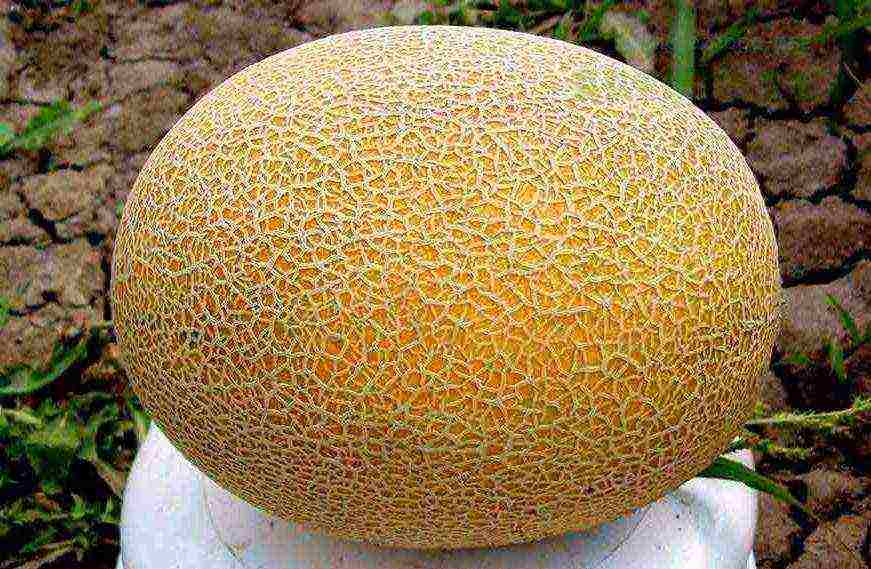
A mid-early hybrid of a melon, the period from full germination to the first harvest of fruits is 62-66 days. The plant is strongly plaited. The leaf is medium-sized, green, slightly dissected.
The fruit is oval, dark yellow at the stage of maturity, smooth, with a continuous thick net. Fruit weight 1.2-1.9 kg. The pulp is light creamy, thick, tender, melting, juicy, of excellent taste with a strong aroma. The dry matter content is 8.5-9.8%, the total sugar content is 5.4-7.6%. The seed nest is small, the placenta is central, dry, closed. Seeds are medium in size, oval, blunt-pointed, creamy yellow.
Yield marketable fruits on dry land 94-156 c / ha, for the Otrada standard - 104-128 c / ha. The maximum yield is 260 c / ha, 172 c / ha higher than the Tamanskaya standard (Krasnodar Territory).
Hybrid advantages: transportable, tolerates waterlogged soil well, resistant to fusarium.
Melon hybrid Caramel F1 in 2009 was included in the State Register of the Russian Federation for the North Caucasus region.
Originator: CLAUSE (France).
Melon Aikido
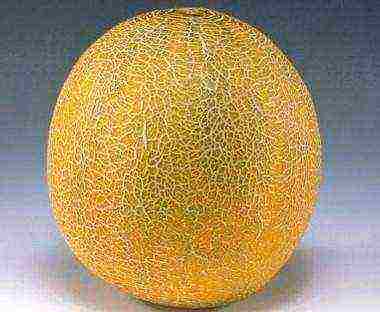
Mid-early - mid-season melon hybrid. The plant is climbing. Medium-sized leaf, dark green, dissected.
The fruit is round, yellow at the stage of maturity, segmented, with a net of medium density, weighing 1.4-2.1 kg. The pulp is light green, thick, melting, tender, juicy. The taste is good and excellent. Melon aroma. Seed nest of medium size, placenta - 3, their position is central. The seeds are creamy yellow, medium in size.
Yield marketable fruits on dry land 92-119 c / ha, at the level of the Otrada standard, for the first two harvests - 34-56 c / ha, at the standard level.
The hybrid is resistant to fusarium.
Melon Aikido F1 in 2006 was included in the State Register for the North Caucasus region for cultivation in private farms.
Originator: SAKATA.
Melon Raymond
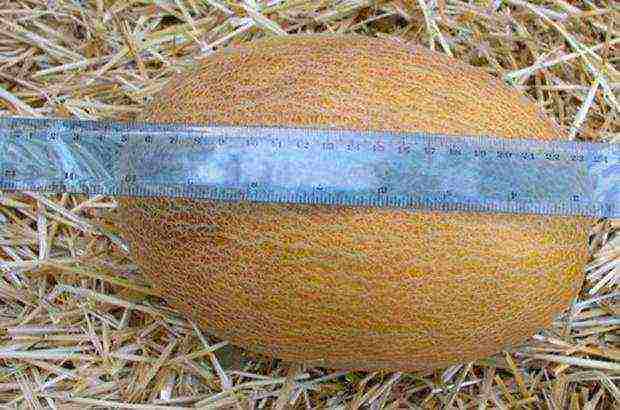
Medium early hybrid, the period from full germination to the first harvest of fruits 65-75 days, 2-5 days later than the Golden standard. The plant is climbing. Medium to large leaf, light green to green, slightly dissected to dissected.
The fruit is elliptical, yellow with an ocher tinge, smooth, slightly wrinkled, with a dense, medium-thick mesh. Fruit weight 2.0-3.6 kg. The pulp is creamy, thin, crispy, tender, medium-bodied, good taste. The dry matter content is 9.2-9.3%, the total sugar content is 6.6-6.9%. The seed nest is medium in size, the placenta is central, semi-liquid, open. Seeds are blunt-pointed, creamy yellow.
Yield marketable fruits in the North Caucasian region when grown on dry land 108-284 c / ha, 7-213 c / ha higher than the standard, in the Lower Volga region when grown on dry land -112-128 c / ha, for the standard - 56-96 c / ha / ha, with irrigation - 214-346 c / ha, for the standard - 258-359 c / ha.
The hybrid is transportable. The fruits retain their commercial qualities for 30-40 days after picking.
Melon Raymond F1 in 2011 it was included in the State Register of the Russian Federation for the North Caucasus and Lower Volga regions.
Originator: HAZERA (Israel).
Melon Dune
An early ripe variety, the period from full sprouting to the first harvest of fruits is 58-75 days. The plant is climbing. The leaf is medium-sized, green, slightly dissected.
The fruit is oval, yellow at maturity, solid mesh, medium density. The average weight of the fetus is 1.4-1.7 kg. The pulp is light creamy, thick, grainy, dense, tender, juicy, of excellent taste. Melon aroma. Seeds are oval, blunt-pointed, medium-sized, ivory-colored. The mass of 1000 seeds is 41 g. The seed yield is 0.7%.
Yield marketable fruits on dry land 92-150 c / ha, 5-28 c / ha higher than the Autumn and Zolotistaya standards, with irrigation - 374-398 c / ha, at the level of 108 c / ha higher than the Zolotistaya standard.
The variety has good transportability.
Melon variety Dune in 2008 was included in the State Register for the Lower Volga region.
Originator of the variety: Bykovskaya Melon Breeding Experimental Station VNIIO.
Melon Cossack

A mid-season variety, the period from full sprouting to the first harvest of fruits is 70-95 days. The plant is long-leaved, medium-sized, with a thin stem. The leaf is reniform, strongly globular, of medium size.
The fruit is oval, medium-sized, weighing 1.2-1.8 kg. The surface of the fruit is smooth or slightly segmented, at the stage of maturity is bright yellow, without a pattern, sometimes mesh elements are found. The bark is hard, medium-strength. The pulp is white, of medium thickness, fibrous, slightly crunchy, dense, juicy, sweet. The severity is average. The seed nest is medium in size. The palatability of the fruit is good.
Yield: 17.7-28.7 t / ha.
The variety is moderately affected by powdery mildew and anthracnose.
Variety value: good transportability of fruits. Approved for use in the North Caucasian and Lower Volga regions in 1964.
Originator of the variety: JSC ‘ROSTOVSORTSEMOVOSCH’
Melon Cinderella
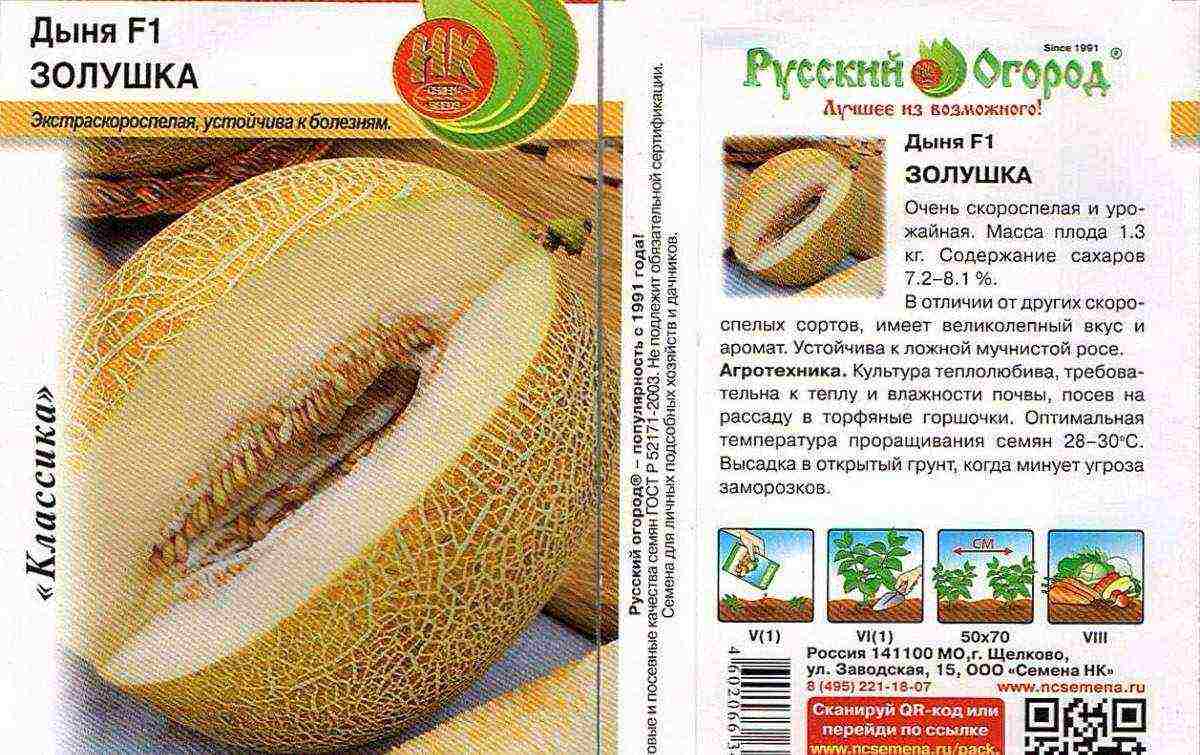
An early ripening variety, the period from full germination to removable ripeness (first harvest of fruits) 60-72 days. The plant is climbing. The leaf is medium-sized, green, slightly dissected.
The fruit is oval, yellow, without a pattern, smooth, with a solid mesh, weighing 1.1-2.2 kg. The pulp is light creamy, 3.0-3.5 cm thick, crispy, juicy, tender, of good taste. The dry matter content is 7.0-11.4%, the total sugar content is 5.4-9.3%. The seed nest is small, consisting of three central, dry, open placentas. Seeds are narrow oval, ivory. The mass of 1000 seeds is 46 g. The seed yield is 0.7%.
Marketable yield fruits 134 c / ha, for the first two harvests - 96 c / ha. The output of marketable products is 85%.
Melon Cinderella is recommended for local consumption. The fruits retain their commercial qualities for 15-20 days after picking.
The variety is resistant to low and high air temperatures.
In 2005, the Cinderella melon variety was included in the State Register of the Russian Federation for garden plots, home gardens and small farms.
Originator: BRANCH KUBAN OS VIR (KRASNODAR REGION).
Melon Tamanskaya
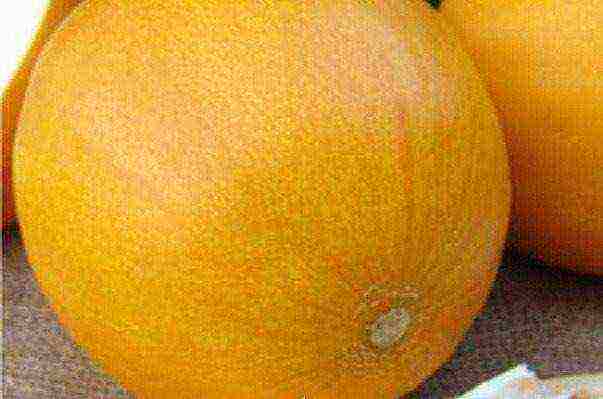
An early ripening variety, the period from full sprouting to removable ripeness (first harvest of fruits) is 53-80 days. The plant is climbing. The main lash is of medium length. The leaf is medium-sized, green, slightly dissected.
The fruit is oval, yellow in color, without a pattern, smooth, with a mesh of medium density. The seed nest is large, the position of the placentas is wall-mounted, the structure is open. The bark is thin, creamy on the cut. The pulp is creamy, of medium thickness, crumbly, grainy, tender, juicy. Fruit weight 0.5-1.3 kg. Good taste. The dry matter content is 8.1-12.5%, the total sugar content is 5.7-11.2%. Seeds are narrow oval, ivory. The mass of 1000 seeds is 28 g.
Yield marketable fruits on dry land 49-169 c / ha, for standards Zolotistaya and Otrada - 55-217 c / ha, for the first two harvests 34-104 c / ha, for standards - 37-78 c / ha.
The variety is transportable.
Melon variety Tamanskaya in 2004 was included in the State Register of the Russian Federation for the North Caucasus region.
Originator of the variety: VNII RISA (Krasnodar).
Melon Temryuchanka
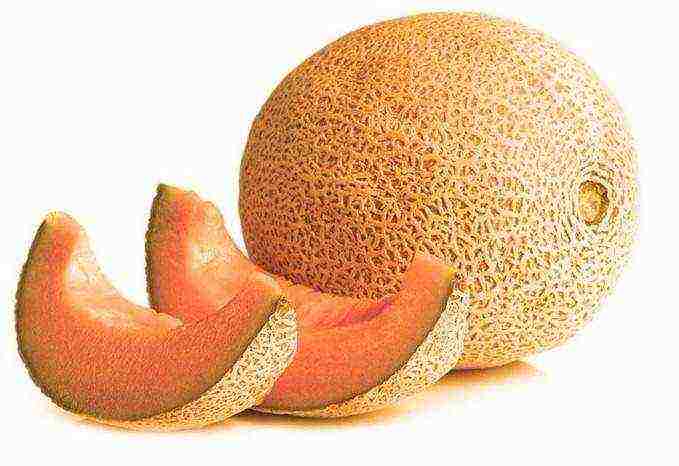
A mid-season variety, the period from full sprouting to the first harvest of fruits is 70-95 days. The plant is climbing. The leaf is medium-sized, green, slightly dissected.
The fruit is round, at the stage of maturity, dark yellow, without a pattern, slightly segmented, strongly wrinkled with a thick continuous mesh. Fruit weight 1.4-2.1 kg. The pulp is light creamy, thick, tender, melting, juicy, very sweet, excellent taste, with a melon aroma. The dry matter content is 8.3-11.1%, the total sugar content is 5.5-8.7%. The seed nest is small. The seeds are large, oval, blunt-pointed, ivory-colored. The mass of 1000 seeds is 35-40 g. The seed yield is 1.1%.
Yield marketable fruits on dry land 108-178 c / ha, 11-27 c / ha higher than the standards of Kazachka 244 and Zolotistaya. The maximum yield is 317 c / ha, 186 c / ha higher than the Zolotistaya standard (Krasnodar Territory).
The variety is transportable, resistant to stressful conditions.The fruits retain their commercial qualities for 25-30 days after picking.
The melon variety Temryuchanka in 2008 was included in the State Register of the Russian Federation for the North Caucasus and Ural regions.
Originator of the variety: VNII RISA, Tsybulevsky Nikolay Ivanovich (Krasnodar).
Melon Gold of the Scythians
Medium early hybrid of a melon, the period from full germination to removable ripeness (first harvest of fruits) 70-80 days. The plant is climbing. The leaf is medium in size, light green, slightly dissected, strongly toothed along the edge, slightly wavy.
The fruit is round in shape, when ripe it is yellow, with a thin dense net. The seed nest is medium in size. The position of the placentas is central. The pulp is creamy, 3.5 cm thick, melting, tender, juicy, sweet, aromatic. Fruit weight 1.1-1.3 kg. The taste is excellent. Seeds are narrow oval, ivory. The mass of 1000 seeds is 41 g.
Yield marketable fruits 6 kg / sq.m.
Hybrid value: high yield, excellent taste of fruits, resistance to powdery mildew.
In 2002, the Zlato Scythian F1 hybrid was included in the State Register of the Russian Federation for garden plots, home gardens and small farms for growing under film shelters.
Originator: LLC Selection firm Gavrish.
If you grow any other good melon varieties, please share your opinion in the comments. If possible, attach a photo of them. Your feedback on the varieties of melons will help many of our readers to learn more about them and decide which varieties and hybrids to plant on their site.
Early melon varieties mature within 60-70 days. This is a very short time, thanks to which a chance to grow a tasty, juicy melon appears even among summer residents in northern regions with an unpredictable climate. The best early varieties of melons will be discussed in the article.
Which early melon varieties are best?
The best early varieties of melon are distinguished by an early ripening period, excellent taste and survival rate in different climatic zones.
- "The dream of a lazy person" or "Dream of Sybarite" ripens in only 50-55 days. Fruits are medium, elongated, up to 500 g. The peel is green-striped. The pulp is juicy and sweet, with a honey aroma and flavor. Up to 15 fruits can ripen on one bush per season.
- "Muscat White" - the growing season is 60 days. Fruit weight - 600-2000 g. The pulp is white, juicy, sweet, but if it ripens, it will taste sugary-sweet. It is very resistant to temperature extremes and frost, so it is grown in greenhouses even in the northern regions.
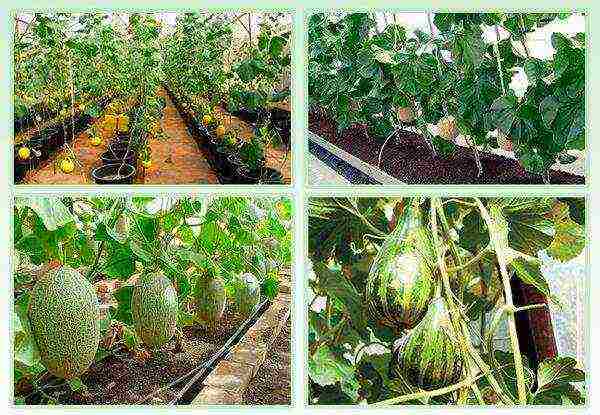 Melon in the greenhouse
Melon in the greenhouse - "Caramel" - high-yielding, early ripening (60-66 days) variety of melons. Fruits are oval, yellow-green with a mesh pattern, weighing 1.6-1.9 kg. The pulp is very aromatic and sweet (sugar - 7.6%). Transportable, resistant to fusarium, tolerates high humidity.
- "Delano F1" matures in 65 days, and at least 55 days under good conditions. Frost-resistant variety, can be grown outdoors or in a greenhouse. The fruits are oval, from 2.5 to 5.5 kg, yellow-orange in color. The peel is mesh. Differs in resistance to diseases.
- "Cinderella" has dark yellow, reticulate, medium-sized fruits weighing up to 1.3 kg. Ripens by 62-70 days. The pulp is very sweet, compared to some other varieties - the sugar content is 8.1%. The pulp is white or creamy, aromatic, soft. The skin is thin. Can be stored for up to 2 weeks - transportable. Resistant to diseases and temperature extremes.
- "Early 133" grown outdoors or in a greenhouse. The growing season is 60-70 days. The fruits are round, yellow, with a barely noticeable mesh. The pulp is white, juicy and sweet, crunches. It is appreciated for its transportability and resistance to anthracnose and fusarium.
- Titovka - early variety, ripens in 60-70 days. Fruits weighing up to 2 kg. The peel is yellow with a small mesh. The pulp is fibrous, juicy, sweet. It is often grown commercially due to its high resistance to frost and disease.
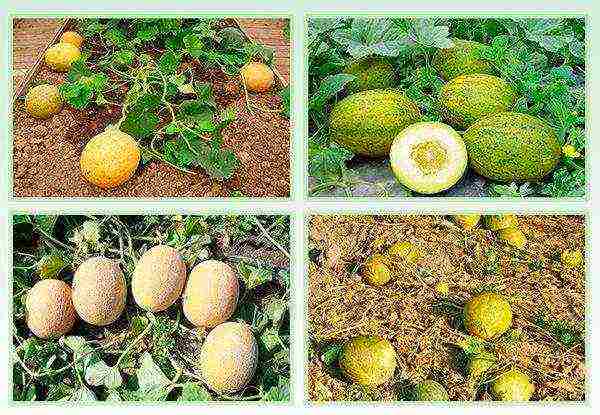 Melon in the garden
Melon in the garden - "Amal" - early ripening hybrid variety, ripens in 70 days. Fruits are elongated, yellow with a light mesh on the rind.The pulp is pale, tender and juicy. The variety has many advantages and disadvantages. So, for example, a melon is resistant to fungi, some diseases, pests, tolerates a cold snap without problems, but requires painstaking care: weeding, the right place without drafts, fertilization. Sugar in 100 g is about 7%.
- "Star in the garden" or "Silver Star" - the growing season is 63-68 days. It looks like a big white egg with a green spot. Fruit weight is about 2 kg. The pulp is white with a greenish tinge, has a delicate, piquant taste. But the variety has many disadvantages: thermophilicity, poor tolerance to temperature changes, humidity. Doesn't like transplants. If it is grown in the middle lane, then only in greenhouses.
The best varieties also include the ultra-early ripening melon "Melba", which can ripen in just 30 days, but at the same time its taste suffers a little (it is not very sweet). This also includes: "Dune", "Roksolana F1", "Dakar", Kalmychka ".
What are the sweetest early melons?
Early melon varieties are very rarely sweet, at least not as honey-sweet as late or mid-season varieties. That is why they are rarely planted in plots. However, thanks to selection, many sweet varieties of early ripening have recently appeared. Here are three of the most popular and available ones for sale.
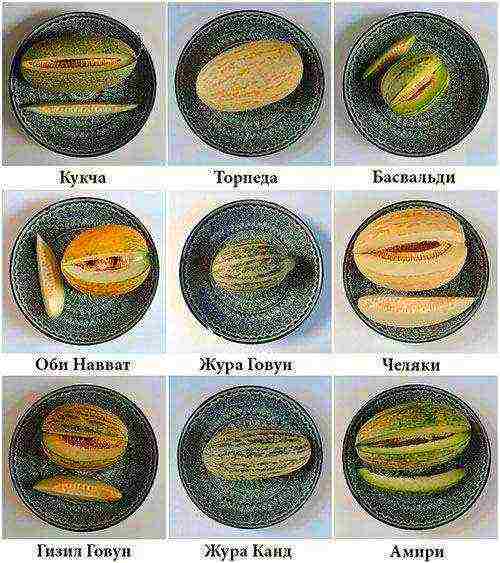 Melon varieties Torpedo
Melon varieties Torpedo
- "Portento F1 " ripens in 65-70 days from the day of planting seedlings. This melon has a record 15% glucose per 100 g of early ripening melon! This is an Italian hybrid. The fruit is light with a spider web pattern and green stripes weighing up to 2.5 kg. The pulp is yellow-orange, juicy, aromatic, and of course sweet.
- Anamax F1 or pineapple melon is a hybrid created by American breeders. This variety is incredibly sweet considering that it ripens 65 to 70 days when planting seedlings. The percentage of sugar in 100 g is 12-13%. The average fruit weight is 3 kg.
- Altayskaya melon has a light orange, sweet flesh. Fruits are oval, yellow-orange, with a net, reach 0.8-1.6 kg, ready to eat on day 63-70. Of the advantages, resistance to temperature extremes, sharp frosts, and pests is noted. But there is also a significant drawback - even with proper care, the plant may not bear fruit.
How to choose and where to buy seeds?
In order to get a good harvest, you need to take high-quality seed for planting.
- Early melon varieties are selected according to the climatic conditions of the region. For the middle and northern regions, these should be frost-resistant crops, which, ideally, can be grown in greenhouse conditions. If you take a thermophilic culture, it will either not yield a harvest, or it will be very bad.
- The variety should be indicated on the package with seeds, and if it is a hybrid, then there should be a note to that effect. Ideally, the manufacturer's address and complete information about the variety are written on the package: when to seedlings, plant, harvest, and so on.
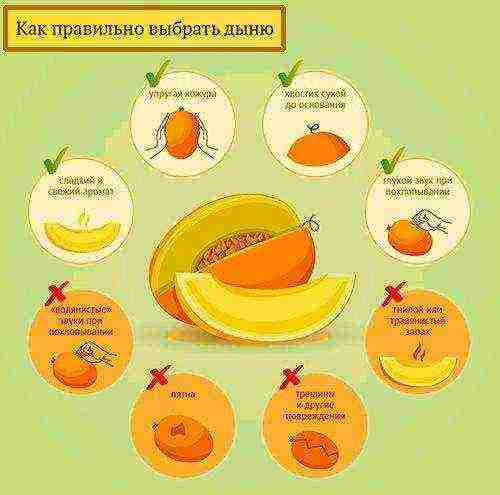 How to choose the right melon
How to choose the right melon - Seeds are not harvested from hybrid varieties, since they simply do not germinate; for these purposes, a simple varietal culture is taken.
- It is recommended to buy seeds in good stores, and not in the market without the name of the variety and the rules for planting it. This will save time and effort in searching for information, and will also bring more benefits, because the seeds in the markets are usually defective.
- Buying a varietal melon or hybrid is a matter of personal taste. Early hybrids are very sweet, and varietal seeds can be harvested for growing in subsequent years. But if you know a place where good hybrid seeds are sold, then why collect them from the grown fruits?
Sweet, tender, juicy, with aromatic crunchy pulp, the golden beauty is a favorite among summer fruits. This is not just a sweet fruit, but a whole storehouse of nutritious minerals, vitamins A, C, P, ascorbic acid. The fruits of this melon plant are considered one of the paradise fruits.Juicy, large melons can be eaten raw, jams and sauces are prepared from them, slices are used in desserts and as a side dish. It goes well with a good beef steak.
Description of sweet dessert
This culture was known a couple of thousand years ago in Ancient Persia and Egypt. In Russia, it appeared already in the 16th century. Under Tsar Peter, it was grown in special greenhouses.
This delicacy has the following composition:
- water;
- proteins;
- carbohydrates;
- cellulose;
- pectin;
- vitamins A, B1, B2, B3, B9, C, E;
- potassium;
- calcium;
- magnesium;
- sodium;
- phosphorus;
- iron;
- iodine;
- manganese;
- copper;
- fluorine.
Doctors advise eating foods from the fruits of this plant while losing weight. They help remove excess fluid from the body and are even a good remedy for cellulite. They strengthen the immune system and normalize the menstrual cycle.
But for diabetics and people with diseases of the gastrointestinal tract, it is better not to eat this delicacy.
Any sweet tooth is looking forward to summer to finally taste delicious fruits - the first melon harvest. The sunny melon delicacy adored by adults and children has a variety of characteristics. It depends on which variety you choose. It can be an elliptical melon, yellow with white flesh, Snowflake F1, round melon with an orange mesh skin, Dubovka melon, or Melon Sweet miracle. The name of the variety of this melon speaks for itself about its characteristics.
Growing this fruit is not easy: the plant is not resistant to various diseases and pests, and is sensitive to temperature extremes. Cultivation begins with the selection of the right place: cultivation will be successful in a warm, windless area with fertile soil. You can feed the soil in the early stages with organic, potash and phosphate fertilizers. It is better to buy Dutch melon seeds and plant them in peat pots for seedlings, but still a high-quality and lush harvest is guaranteed only if you choose the melon variety that suits the climatic conditions of the landing site.
Much has been written about what melons are. But we decided that it would be better to sort everything out on the shelves and present the best varieties, dividing them into groups according to the ripening period.
Early varieties
The largest number of lovers of the first type. Early types of melons are those with sixty-five days from cotyledon emergence to harvest. Such plants thrive in areas with short and cool summers. They are great for wholesalers. Growing them is inexpensive because of their early maturity.
The early ripe ones include dwarf and ordinary individuals: Titovka melon (the most popular variety among gardeners), Roksolana melon, Ambrosia melon, Ignazio melon, Dina melon, Cinderella, Assol, Altai, Scythian gold, Raymond, Delano, Bijur and others.
The early melon crops include a whole type - the Galia melon. Do not confuse the types and varieties of melons. The type unites varieties of individuals with similar characteristics: super early, bright yellow, like bananas, round, small in size. This is an Indian melon culture, but it is believed that it was developed in Israel. Melon Galia also exists as a variety. The flesh of the melon is greenish-white, crispy.
Raymond loves warm areas under the sun. During planting by seedlings, the fruits become ripe in a month and a half, when sowing seeds in open ground - after 60–65 days. Raymond F1 is famous for its large pumpkins, ideal oblong shape. The skin has a bright yellow net color, ribbed to the touch, dense. The inside of a ripe dessert vegetable is comparatively not very juicy and has a honey flavor. The seed chamber occupies a very small percentage of the area. The plant is short, with a powerful root system. When the weather is suitable for the correct development and the correct agronomic approach, the culture sets 5 fruits each.
Scythian gold has a ripening period of up to eighty days. It demonstrates itself best in greenhouses.The fruits are round, yellow, reticulate, small (1–1.5 kg). Growing begins in seedlings at the beginning of May. They are planted in open ground according to the scheme 70 by 150 cm.
Delano is an early ripening variety with abundant fruiting. Fruits are elliptical, reticulate, weighing up to 6 kg, sunny in color. The pulp is snow-white, without fibers, with a small seed chamber. Has a very strong characteristic aroma. Up to 4 fruits are tied on the plant, while it is recommended to sow 6-8 thousand seeds per hectare.
The fruits are resistant to disease and weather variability. Very presentable and perfectly transportable.
Ignazio F1 is a highly productive hybrid. Many fruits are set on one plant. A massive leaf system shelters the fruits from the sun's rays. The fruits themselves are elliptical, weighing up to 5 kg, have a hard peel. The snow-white inside, fleshy, during storage remains the same as when collected. Stored for several months.
Roksolana F1 is an early ripe hybrid that belongs to the above-described species. Ripens in about sixty-five days. Thanks to the massive leaf system, the fruits do not get sunburn. The flesh is creamy and the rind is light yellow. Requires a well-lit area. Care includes pinching, watering and feeding.
Assol belongs to the Altai species. The fruits are obtained with a weight of 1000 g. The peel is dirty yellow in color with green stripes. The inside is grainy, tender, juicy.
Winter melon (cassaba) is an early plant that has medium-weight spherical fruits. The rind is golden or creamy. A feature of the cassaba melon is its high transportability and increased taste during the winter storage period.
Melon varieties such as Pineapple are also early. Melon Oksana F1 belongs to this type. This is a hybrid, insensitive to fusarium wilt and powdery mildew, which is not difficult to grow. Striped melon is also considered pineapple.
Bizhur - hybrid is a very early, high-yielding plant of the Pineapple cultivar. It matures over seventy days and has a powerful leaf system. Has an oval or oval-elongated shape. Fruit weight varies from 2 to 3 kg. The inside is very juicy and sweet. The fruit tastes like honey, suitable even for baby food.
Melon Goldie is a pineapple-type hybrid known for its high yields, honey flavor and disease resistance. The average weight of a mature plant is 3.5 kg.
The F1 Lychee melon is practically the earliest melon of melons, because its ripening period is about thirty-five days. Why is it so attractive to growers? Because its peel is not yellow, not pink, or even orange, but white, like a chamomile.
Melon Golpri Gold has the following description: 2-3 fruits are formed on one plant, the average weight of which is 3000 g. Golpri Gold F1 has an orange skin and soft creamy flesh. Differs in its heat resistance.
Mid-season varieties
Melon Don Quixote, Primal, Anzer, Cappuccino, Northern Star melon, Anna Max melon, Jumbo, Chogare, Assate, Sunny delicacy melon, Hermius, Luna are considered to be medium early. Their ripening period does not apply to either the early or the average and is seventy days.
Fruits are globular, creamy yellow rind with a wide net. On average, the fruits weigh 1.5 kg. The inside is dense, sugary, pleasant to the taste. 10 thousand seeds are sown per hectare. The hybrid is resistant to stressful conditions, fusarium and other melons and gourds. The fruits are good for transportation and storage.
Jumbo has a ripening period of 90-100 days from the start of sowing. Produces a good harvest when grown in greenhouses. The plant is powerful, climbing. Fruits are elongated, elliptical, weighing up to two kilograms, depending on the observance of the rules of agricultural technology. The skin is reticulate, with distinct segments, creamy yellow with light green color. The inside is orange in color.The dessert vegetable tastes great, has a fiberless texture, and is resistant to a number of common diseases.
Sowing: at the end of April in peat pots at a temperature of 25-30 degrees Celsius. It is necessary to transplant into a greenhouse when 4 true leaves appear, and into fertile soil.
Care includes such processes as pinching, regular but moderate irrigation, fertilizing with complex fertilizers. The crop is ready to be harvested at the end of summer.
Don Quixote F1 is a mid-season hybrid with oblong fruits of about 5 kg. The skin is green with a distinct mesh. The inside is white and soft, sweet, sugary. The fruits are stored for almost ninety days.
The hybrid is bred in such a way that it is resistant to fusarium, powdery mildew.
Melon Kamar is a plant with rounded-elongated mesh-type fruits and a very small seed chamber. Feature - high resistance to fusarium wilt.
Melon Chudo-Yudo - medium early, has round fruits weighing up to 2.5 kg. The name of the melon does not inspire confidence, but in fact, the fruits are very presentable and sweet.
Mid-season popular varieties: Marquise melon, Sweet Tooth melon, Bereginya, Dzhukar.
Melon Blondie is recognizable for its characteristic stripes on the white skin. It is better to start growing this variety in April. Its fruits are the smallest among all white melons - about 600-700 g.
Ethiopian has a ripening period of eighty days. The plant does not spread widely. The leaves are heart-shaped, and the fruits are round, light yellow, very clearly segmented. The inside is white and dense.
Amal F1 is the most popular mid-season variety. From the moment of emergence to fruiting, an average of seventy-nine days pass. The fruit is very presentable and attractive to consumers. It is light golden, oval and reticulate. The pulp is tender, melts in the mouth, yellow with a pinkish tinge. Perfectly transported for about a month. Excellent candied fruits and marmalades are prepared from this variety.
Melon Creme brulee is a mid-season long-leaved plant. The fruits are oval, smooth, yellow-orange, like cauliflower.
Melon Unusual F1 - really from the "exotic" section, because it looks more like a pumpkin. Usually it is grown under a film (less often in the open field). The pulp is oily, very juicy and fragrant.
Late varieties
Late melon is the most popular among gardeners. Obviously, everyone has heard of such varieties as Princess Maria melon, Powdered sugar melon, Emerald melon, Torpedo, Walking.
Princess Maria is known among gardeners for good germination, balanced taste and unusual color. This is a late hybrid. Fruits are spherical, gray-green, with a whitish mesh. They grow to a mass of 1.3–1.5 kg. The pulp is rich orange, juicy, sugar, with a nutmeg aroma. The peculiarity of the hybrid is its resistance to bacterial and viral diseases.
It is cold-resistant, has a wonderful aroma, and is suitable for storage. In areas with a cold climate, this hybrid is grown under a film in a greenhouse. Leaving necessarily includes pinching the shoots. Watering is stopped 10-15 days before ripening. This variety can be eaten without heat treatment, and sweets can also be prepared.
Melon Zimovka is a late variety of the Altai type. The flesh of the melon seems to be emerald in color, of medium thickness. The weight of the fetus reaches 2.5 kg. It is easily transported and stays sweet for a long time. You can harvest on the ninetieth day.
Torpedo - this variety ripens for more than 110 days. This plant is excellent for long-term storage and transportation. Until early spring, fruits weighing 5–8 kg do not lose their taste. They are elongated in shape, yellowish, covered with a fine mesh. The inside is soft, juicy, snow-white. A pleasant aroma comes out during cutting.
Gulyabi is a Central Asian sweet melon. Ripens in 133 days and yields 15 kg per square meter. Fruits are egg-shaped, weighing up to 8000 g.The surface is divided into small, barely visible segments. The fruit is dark yellow in color, with a hard skin.
The late types of melons include Piel de Sapo. This type combines oval, crack-resistant, ribbed fruits weighing up to 2.2 kg. The flesh is snow-white, and the rind is hard and dark green. This type includes the varieties Ricura and Mabel.
Whatever the variety, it is affected by the same diseases and pests. These are powdery mildew, fusarium wilting, peronosporosis, anthracnose, root rot. Unwanted guests are melon aphids, wireworms and spider mites.
You need to be prepared for all these diseases in advance so that the money spent on quality seeds is not wasted.
Each of them determines the best varieties of melon according to their own criteria. Someone needs walnut-sized fruits, someone likes exotic, unusual melons like Kiwano. Someone is worried about growing and trying to find the best seeds.
It doesn't matter if it is bush melon, Turkish orange melon, banana melon or kiwi melon. The main thing is to follow all the most important stages of growing and care. Then the sweet beauty will delight with aroma and summer taste on the family table and bring a huge income.
Video "Planting melons in open ground and greenhouse"
In this video, you will learn how to plant plants in open ground and in a greenhouse.
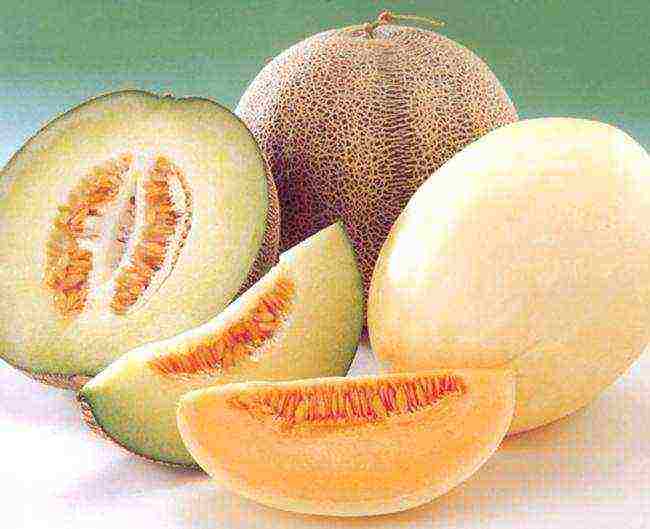
As you may have learned from our previous articles, the melon can be grown both in the greenhouse and in the open field. To get a decent harvest, you must not only choose the right place for planting and properly care for the plant, but also choose the right melon variety.
If you decide to grow a melon in your garden plot, it is worth considering all the nuances associated with planting this plant. When choosing varieties of melon for planting, take into account the climatic characteristics of your region. For our strip, it is better to choose melon varieties with an early growing season.
By choosing melon varieties, proceed also from the place of planting: in the greenhouse or in the open field. In today's article, we will focus on the best melon varieties, varieties and hybrids that are suitable for growing in our region, both in greenhouse conditions and in the open field.
The best melon varieties
Melon varieties for open ground and greenhouses
Let's start with the most popular and favorite melon variety for gardeners - the Kolkhoznitsa melon variety.
Melon variety "Kolkhoznitsa"
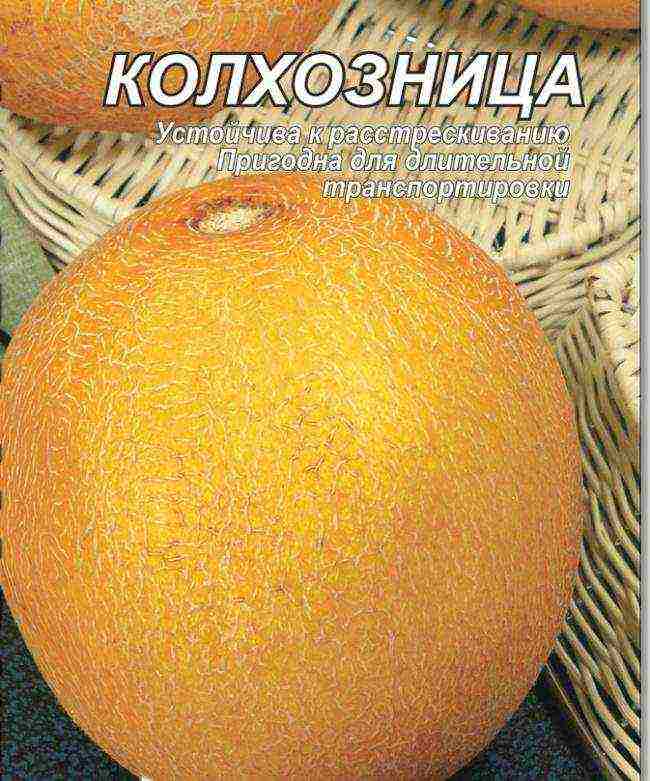
"Kolkhoznitsa" refers to mid-season melon varieties. This variety is grown both in the greenhouse and in the open field. The growing season is 75-95 days. Melon has a spherical shape, yellow-orange color, barely noticeable mesh on the peel. "Kolkhoznitsa" has a dense, light flesh. Most often it weighs no more than 1.5 kg. Has unsurpassed taste and wonderful aroma.
"Kolkhoznitsa" is not intended for long-term storage, but it has a number of other "positive qualities". This variety is distinguished by good transportability, resistance to low temperatures, cracking and various diseases. The Kolkhoznitsa variety is eaten both fresh and used for making all kinds of desserts, jams, etc.
Melon variety "Pineapple"
"Pineapple" is an equally popular variety among summer residents. Grown both in greenhouses and in the open field. This variety is medium early. The growing season is 70-80 days. The fruits are round, slightly oblong in shape. Color - yellow-orange, sometimes brown. The pulp is juicy, dense, very sweet, with a certain pineapple aroma, can have a pale pink hue.
"Pineapple" perfectly tolerates transportation, is resistant to late blight, powdery mildew. It is eaten both fresh and dried, used for making jams, preserves, etc.
Melon variety "Altai"

"Altayskaya" is an early ripening variety of melon. This variety is grown both in the greenhouse and in the open field. The growing season is 62-70 days. The melon is oval in shape, with a yellow rind.The peel is thin, the pulp is tender, sweet, melting in the mouth, the thickness of the pulp is 2.5-3 cm. The average weight of the fruit is 1.5 kg.
Differs in early and amicable ripening of fruits. Melon "Altai" is adapted to unfavorable weather conditions, suitable for long-term transportation, has good keeping quality, but is not highly resistant to diseases. Suitable both for raw consumption and for any culinary processing.
Melon variety "Golden"
Melon "Golden" refers to mid-season melon varieties. This variety is grown both in greenhouses and in the open field. The growing season is 75-80 days. The fruit is more often rounded, yellowish-orange in color. The pulp is firm, white, aromatic, tender, juicy and very sweet. The average weight of the fetus is 1.5 kg.
"Golden" does not react well to high humidity. This variety is valued for its stable yield, for its high rates of transportability, for its excellent resistance to diseases and low temperatures and other unfavorable conditions. It is often consumed fresh.
Melon variety "Titovka"
Melon "Titovka" belongs to the ultra-early ripening varieties. This variety is grown both in greenhouses and in the open field. The growing season is 55-70 days. Fruits are round, yellow or orange in color. The pulp is thick, white, firm, sweet, fragrant. Average fetal weight is 2 kg.
"Titovka" is demanding on light and heat. It is appreciated for the early ripening period, excellent yield, amicable ripening of fruits, for excellent transport tolerance, for resistance to bacteriosis and aphid aphids, for unsurpassed taste. This variety is often consumed fresh.
Melon variety "Early 133"
"Early 133" refers to early maturing varieties. It is used for cultivation both in the greenhouse and in the open field. The growing season is 60-70 days. The fruits of this variety have an oval-round shape, yellow skin color. The pulp is white, dense, thick, tender, sweet, aromatic, has excellent taste. The average fruit weight is about 1.5 kg.
"Early 133" is valued for its excellent commercial qualities, for its excellent transportability, for its resistance to fusarium wilting and anthracnose. It is eaten both fresh and used for culinary processing.
Melon variety "Sweet pineapple F1"
F1 Sweet Pineapple is an early ripening hybrid. Designed for growing both in the greenhouse and in the open field. The ripening period is 65-70 days. Fruits are usually round, sometimes oblong. The bark of the melon is covered with a yellow-green mesh. The pulp is bright orange in color, the pulp is juicy, tender, with a kind of pineapple aroma. Average weight - 1.5 kg.
"Sweet Pineapple F1" is resistant to many diseases, has high taste and vitamin qualities. It is consumed fresh, used to prepare a wide variety of desserts.
So, we have considered the most popular varieties of melon, however, in addition to them, there are also a huge number of universal varieties and hybrids that are grown both in greenhouse conditions and in the open field. These include: Melon Mead F1, Melon Early Sweet, Melon Alina, Melon Charlotte, Melon Ethiopka, Melon Amal F 1, Melon Bereginya, Melon Dubovka, Melon Credo F 1 and others.
Tatiana Kuzmenko, member of the editorial board Sobcor of the Internet edition “AtmAgro. Agroindustrial Bulletin "
